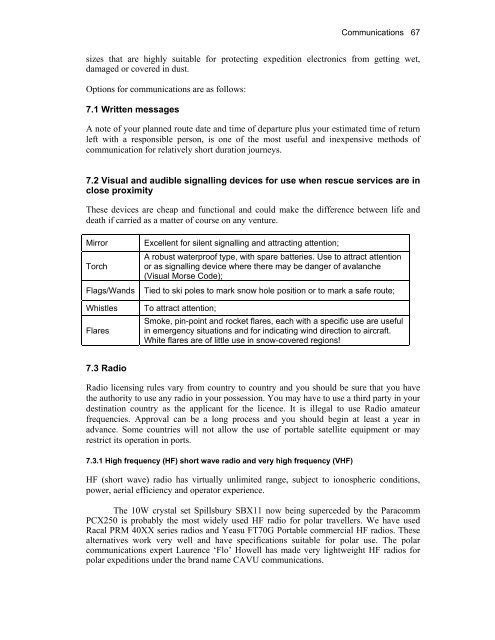Edited by Rachel Duncan 4th Edition ISBN 0-907649-91-2 London ...
Edited by Rachel Duncan 4th Edition ISBN 0-907649-91-2 London ...
Edited by Rachel Duncan 4th Edition ISBN 0-907649-91-2 London ...
You also want an ePaper? Increase the reach of your titles
YUMPU automatically turns print PDFs into web optimized ePapers that Google loves.
Communications 67<br />
sizes that are highly suitable for protecting expedition electronics from getting wet,<br />
damaged or covered in dust.<br />
Options for communications are as follows:<br />
7.1 Written messages<br />
A note of your planned route date and time of departure plus your estimated time of return<br />
left with a responsible person, is one of the most useful and inexpensive methods of<br />
communication for relatively short duration journeys.<br />
7.2 Visual and audible signalling devices for use when rescue services are in<br />
close proximity<br />
These devices are cheap and functional and could make the difference between life and<br />
death if carried as a matter of course on any venture.<br />
Mirror Excellent for silent signalling and attracting attention;<br />
Torch<br />
A robust waterproof type, with spare batteries. Use to attract attention<br />
or as signalling device where there may be danger of avalanche<br />
(Visual Morse Code);<br />
Flags/Wands Tied to ski poles to mark snow hole position or to mark a safe route;<br />
Whistles To attract attention;<br />
Flares<br />
7.3 Radio<br />
Smoke, pin-point and rocket flares, each with a specific use are useful<br />
in emergency situations and for indicating wind direction to aircraft.<br />
White flares are of little use in snow-covered regions!<br />
Radio licensing rules vary from country to country and you should be sure that you have<br />
the authority to use any radio in your possession. You may have to use a third party in your<br />
destination country as the applicant for the licence. It is illegal to use Radio amateur<br />
frequencies. Approval can be a long process and you should begin at least a year in<br />
advance. Some countries will not allow the use of portable satellite equipment or may<br />
restrict its operation in ports.<br />
7.3.1 High frequency (HF) short wave radio and very high frequency (VHF)<br />
HF (short wave) radio has virtually unlimited range, subject to ionospheric conditions,<br />
power, aerial efficiency and operator experience.<br />
The 10W crystal set Spillsbury SBX11 now being superceded <strong>by</strong> the Paracomm<br />
PCX250 is probably the most widely used HF radio for polar travellers. We have used<br />
Racal PRM 40XX series radios and Yeasu FT70G Portable commercial HF radios. These<br />
alternatives work very well and have specifications suitable for polar use. The polar<br />
communications expert Laurence ‘Flo’ Howell has made very lightweight HF radios for<br />
polar expeditions under the brand name CAVU communications.

















